 . For example,
. For example,Problems involving percent are common on the GRE. The word percent means “divided by one hundred.” When you see the word “percent,” or the symbol %, remember it means  . For example,
. For example,

To convert a decimal into a percent, move the decimal point two places to the right. For example,
0.25 = 25%
0.023 = 2.3%
1.3 = 130%
Conversely, to convert a percent into a decimal, move the decimal point two places to the left. For example,
47% = .47
3.4% = .034
175% = 1.75
To convert a fraction into a percent, first change it into a decimal (by dividing the denominator [bottom] into the numerator [top]) and then move the decimal point two places to the right. For example,

Conversely, to convert a percent into a fraction, first change it into a decimal and then change the decimal into a fraction. For example,

Following are the most common fractional equivalents of percents:
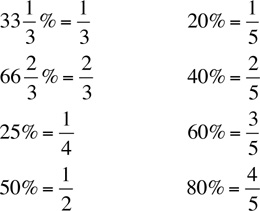
Percent problems often require you to translate a sentence into a mathematical equation.
Example 1: What percent of 25 is 5?
(A) 10% (B) 20% (C) 30% (D) 35% (E) 40%
Translate the sentence into a mathematical equation as follows:
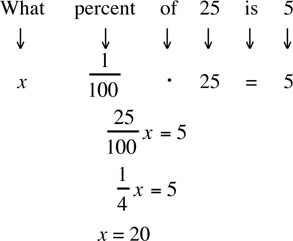
The answer is (B).
Example 2: 2 is 10% of what number
(A) 10 (B) 12 (C) 20 (D) 24 (E) 32
Translate the sentence into a mathematical equation as follows:
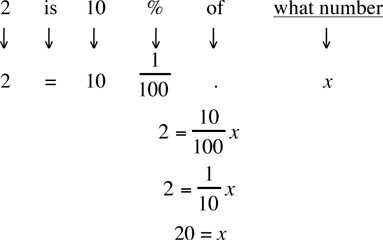
The answer is (C).
Example 3: What percent of a is 3a?
(A) 100% (B) 150% (C) 200% (D) 300% (E) 350%
Translate the sentence into a mathematical equation as follows:
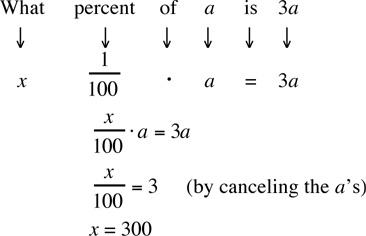
The answer is (D).
Example 4: If there are 15 boys and 25 girls in a class, what percent of the class is boys?
(A) 10%
(B) 15%
(C) 18%
(D) 25%
(E) 37.5%
The total number of students in the class is 15 + 25 = 40. Now, translate the main part of the sentence into a mathematical equation:
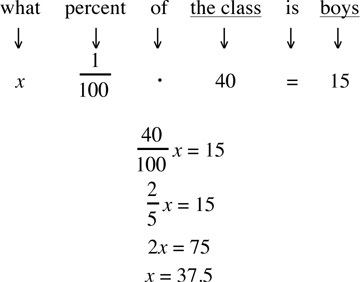
The answer is (E).

Often you will need to find the percent of increase (or decrease). To find it, calculate the increase (or decrease) and divide it by the original amount:

Example 5: The population of a town was 12,000 in 1980 and 16,000 in 1990. What was the percent increase in the population of the town during this period?
(A) 
(B) 50%
(C) 75%
(D) 80%
(E) 120%
The population increased from 12,000 to 16,000. Hence, the change in population was 4,000. Now, translate the main part of the sentence into a mathematical equation:
Percent of change: 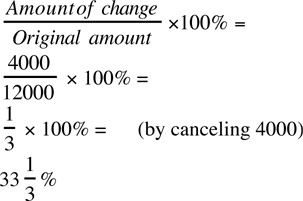
The answer is (A).
 Easy
Easy
1. |
Column A |
3/11 of a number is 23. |
Column B |
2. |
Column A |
|
Column B |
 Medium
Medium
3. In January, the value of a stock increased by 25%; and in February, it decreased by 20%. In March, it increased by 50%; and in April, it decreased by 40%. If Jack invested $80 in the stock on January 1 and sold it at the end of April, what was the percentage change in the price of the stock?
(A) 0%
(B) 5%
(C) 10%
(D) 40%
(E) 50%
4. b equals 10% of a and c equals 20% of b, then which one of the following equals 30% of c?
(A) 0.0006% of a
(B) 0.006% of a
(c) 0.06% of a
(D) 0.6% of a
(E) 6% of a
5. |
Column A |
Item A cost John $90 and item B cost him $100. |
Column B |
|
Percentage of profit that John earned by selling item A with a profit of $10 |
|
Percentage of profit that John earned by selling item B with a profit of $10 |
6. 8 is 4% of a, and 4 is 8% of b. c equals b/a. What is the value of c?
(A) 1/32
(B) 1/4
(C) 1
(D) 4
(E) 32
7. Carlos & Co. generated revenue of $1,250 in 2006. This was 12.5% of its gross revenue. In 2007, the gross revenue grew by $2,500. What is the percentage increase in the revenue in 2007?
(A) 12.5%
(B) 20%
(C) 25%
(D) 50%
(E) 66.3%
8. If 80 percent of the number a is 80, then how much is 20 percent of the number a?
(A) 20
(B) 40
(C) 50
(D) 60
(E) 80
9. In an acoustics class, 120 students are male and 100 students are female. 25% of the male students and 20% of the female students are engineering students. 20% of the male engineering students and 25% of the female engineering students passed the final exam. What percentage of engineering students passed the exam?
(A) 5%
(B) 10%
(C) 16%
(D) 22%
(E) 25%
10. If 9/100 of x is 9, then which one of the following is true?
(A) 25 percent of x is 25
(B) 1/4 of x is 0.25
(C) x is 120% of 80
(D) x is 9 percent of 90
(E) 90 percent of x is 9
11. If 50% of x equals the sum of y and 20, then what is the value of x - 2y?
(A) 20
(B) 40
(C) 60
(D) 80
(E) 100
12. If  and x ≠ 0, then what percentage (to the nearest integer) of x + 3y is x - 3y?
and x ≠ 0, then what percentage (to the nearest integer) of x + 3y is x - 3y?
(A) 20%
(B) 25%
(C) 30%
(D) 35%
(E) 40%
13. |
Column A |
12 students from section A and 15 students from section B failed an Anthropology exam. Thus, equal percentage of attendees failed the exam from either section. |
Column B |
|
Number of attendees for the exam from section A |
|
Number of attendees for the exam from section B |
14. |
Column A |
500% of a equals 500 b. a and b are positive. |
Column B |
|
a |
|
b |
15. |
Column A |
a/2 is b% of 30, and a is c% of 50. b is positive. |
Column B |
|
b |
|
c |
16. |
Column A |
The annual exports of the company NeuStar increased by 25% last year. This year, it increased by 20%. |
Column B |
|
Increase in exports last year |
|
Increase in exports in the current year |
17. |
Column A |
Mr. Chang sold 100 oranges to customers for $300 and earned a profit. |
Column B |
|
The percentage of the profit that Chang got |
|
The selling price of the oranges expressed as a percentage of the cost |
 Hard
Hard
18. The selling price of 15 items equals the cost of 20 items. What is the percentage profit earned by the seller?
(A) 15
(B) 20
(C) 25
(D) 33.3
(E) 40
19. Each person in a group of 110 investors has investments in either equities or securities or both. Exactly 25% of the investors in equities have investments in securities, and exactly 40% of the investors in securities have investments in equities. How many have investments in equities?
(A) 65
(B) 80
(C) 120
(D) 135
(E) 150
20. The value of a share of stock was $30 on Sunday. The profile of the value in the following week was as follows: The value appreciated by $1.2 on Monday. It appreciated by $3.1 on Tuesday. It depreciated by $4 on Wednesday. It appreciated by $2 on Thursday and it depreciated by $0.2 on Friday. On Friday, the stock market closed for the weekend. By what percentage did the value of the share increase in the five days?
(A) 3.2%
(B) 4%
(C) 5.6%
(D) 7%
(E) 10%
21. The percentage of integers from 1 through 100 whose squares end with the digit 1 is x%, and the percentage of integers from 1 through 200 whose squares end with the digit 1 is y%. Which one of the following is true?
(A) x = y
(B) x = 2y
(C) x = 4y
(D) y = 2x
(E) y = 4x
22. The cost of painting a wall increases by a fixed percentage each year. In 1970, the cost was $2,000; and in 1979, it was $3,600. What was the cost of painting in 1988?
(A) $1,111
(B) $2,111
(C) $3,600
(D) $6240
(E) $6480
23. The list price of a commodity is the price after a 20% discount on the retail price. The festival discount price on the commodity is the price after a 30% discount on the list price. Customers purchase commodities from stores at a festival discount price. What is the effective discount offered by the stores on the commodity on its retail price?
(A) 20%
(B) 30%
(C) 44%
(D) 50%
(E) 56%
24. |
Column A |
A stores sells Brand A items and Brand B items at 75% and 80%, respectively, off list prices. During festival season, discounts of 20% and 25%, on Brand A and Brand B, respectively, are offered. Spinach tins of Brand A and Brand B have the same list price. |
Column B |
|
Cost of spinach tins of Brand A during festival season |
|
Cost of spinach tins of Brand B during festival season |
30. If ab = cd and a is 25% greater than c, then by what percent is d greater than b?
(A) 16.66
(B) 20
(C) 25
(D) 30
(E) 33.33
 Very Hard
Very Hard
31. The total income of Mr. Teng in the years 2003,2004, and 2005 was $36,400. His income increased by 20% each year. What was his income in 2005?
(A) 5,600
(B) 8,800
(C) 10,000
(D) 12,000
(E) 14,400
Answers and Solutions to Problem Set U
 Easy
Easy
1. 60% of a number is 60/100 = 3/5 times the number. Hence, 60% of a number is 3/5 of the number. So, the columns are equal. The answer is (C). Note that we did not need the statement “3/11 of a number is 23” to solve the problem.
2. Column A: 45% of 90 =  .
.
Column B: 90% of 45 =  .
.
Since the columns are equal, the answer is (C).
 Medium
Medium
3. At the end of January, the value of the stock is $80 + 25%($80) = $80 + $20 = $100.
At the end of February, the value of the stock is $100 - 20%($100) = $100 - $20 = $80.
At the end of March, the value of the stock is $80 + 50%($80) = $80 + $40 = $120.
At the end of April, the value of the stock is $120 - 40%($120) = $120 - $48 = $72.
Now, the percentage change in price is

The answer is (C).
4. b = 10% of a = (10/100)a = 0.1a.
c = 20% of b = (20/100)b = 0.2b = (0.2)(0.1a)
Now, 30% of c = (30/100)c = 0.3c = (0.3)(0.2)(0.1a) = 0.006a = 0.6%a.
The answer is (D).
5. The formula for the profit percentage is  · 100.
· 100.
Hence, Column A equals 10/90 · 100 = 100/9% = 11.1%, and Column B equals 10/100 · 100 = 10%.
Hence, Column A is greater than Column B, and the answer is (A).
6. 4% of a is 4a/100. Since this equals 8, we have 4a/100 = 8. Solving for a yields a = 8 •  = 200.
= 200.
Also, 8% of b equals 8b/100, and this equals 4. Hence, we have  • b = 4. Solving for b yields b = 50.
• b = 4. Solving for b yields b = 50.
Now, c = b/a = 50/200 = 1/4. The answer is (B).
7. We are given that Carlos & Co. generated revenue of $1,250 in 2006 and that this was 12.5% of the gross revenue. Hence, if 1250 is 12.5% of the revenue, then 100% (gross revenue) is (100/12.5)(1250) = 10,000. Hence, the total revenue by end of 2007 is $10,000. In 2006, revenue grew by $2500. This is a growth of (2500/10000) × 100 = 25%. The answer is (C).
8. We have that 80 is 80 percent of a. Now, 80 percent of a is 80/100 × a. Equating the two yields 80/100 × a = 80. Solving the equation for a yields a = 100/80 × 80 = 100. Now, 20 percent of a is 20/100 × 100 = 20. The answer is (A).
9. There are 100 female students in the class, and 20% of them are Engineering students. Now, 20% of 100 equals 20/100 × 100 = 20. Hence, the number of female engineering students in the class is 20.
Now, 25% of the female engineering students passed the final exam: 25% of 20 = 25/100 × 20 = 5. Hence, the number of female engineering students who passed is 5.
There are 120 male students in the class. And 25% of them are engineering students. Now, 25% of 120 equals 25/100 × 120 = 1/4 × 120 = 30. Hence, the number of male engineering students is 30.
Now, 20% of the male engineering students passed the final exam: 20% of 30 = 20/100 × 30 = 6. Hence, the number of male engineering students who passed is 6.
Hence, the total number of Engineering students who passed is
(Female Engineering students who passed) + (Male Engineering students who passed) =
5 + 6 =
11
The total number of Engineering students in the class is
(Number of female engineering students) + (Number of male engineering students) =
30 + 20 =
50
Hence, the percentage of engineering students who passed is

11/50 × 100 =
22%
The answer is (D).
10. We are given that 9/100 of x is 9. Now, 9/100 of x can be expressed as 9% of x. Hence, 9% of x is 9.Hence, 25 percent of x must equal 25. The answer is (A).
11. 50% of x equals the sum of y and 20. Expressing this as an equation yields
(50/100)x = y + 20
x/2 = y + 20
x = 2y + 40
x - 2y = 40
The answer is (B).
12. Dividing both the numerator and the denominator of the given equation  by y yields
by y yields  . Cross-multiplying this equation yields
. Cross-multiplying this equation yields  . Solving for x/y yields x/y = 7.
. Solving for x/y yields x/y = 7.
Now, the percentage of x + 3y the expression x - 3y makes is  . Dividing both the numerator and the denominator of the expression by y yields
. Dividing both the numerator and the denominator of the expression by y yields

The answer is (E).
13. Given that an equal percent of attendees failed the exam in sections A and B. Let x be the percent. If a students took the exam from section A and b students took the exam from section B, then number of students who failed from the sections would be a(x/100) and b(x/100), respectively. Given that the two equal 12 and 15, respectively, we have a(x/100) = 12 and b(x/100) = 15. Since 12 < 15, a(x/100) < b(x/100). Canceling x/100 from both sides yields a < b. Hence, Column B > Column A, and the answer is (B).
14. We are given that 500% of a equals 500b. Now, 500% of a is  a = 5a. Setting this equal to 500b yields 5a = 500b. Dividing both sides of this equation by 5 yields a = 100b. Since both a and b are positive (given) and a is 100 times b, a is greater than b. Hence, Column A is greater than Column B, and the answer is (A).
a = 5a. Setting this equal to 500b yields 5a = 500b. Dividing both sides of this equation by 5 yields a = 100b. Since both a and b are positive (given) and a is 100 times b, a is greater than b. Hence, Column A is greater than Column B, and the answer is (A).
15. We are given that a/2 is b% of 30. Now, b% of 30 is  . Hence,
. Hence,  . Solving for a yields
. Solving for a yields  We are also given that a is c% of 50. Now, c% of 50 is
We are also given that a is c% of 50. Now, c% of 50 is  . Hence, a = c/2. Plugging this into the equation
. Hence, a = c/2. Plugging this into the equation  yields
yields  . Multiplying both sides by 2 yields c =
. Multiplying both sides by 2 yields c =  . Since b is positive, c is also positive; and since 6/5 > 1, c > b. Hence, the answer is (B).
. Since b is positive, c is also positive; and since 6/5 > 1, c > b. Hence, the answer is (B).
16. Let x be the annual exports of the company before last year. It is given that the exports increased by 25% last year. The increase (Column A) equals (25/100)x = x/4, and the net exports equals x + x/4 = 5x/4. Now, exports increased by 20% this year. So, the increase (Column B) equals (20/100)(5x/4) = x/4. Hence, both columns equal x/4, and the answer is (C).
17. Let C be the cost of the oranges, and let 5 be the selling price of the oranges.
Column A: The percentage of the profit that Chang got is  .
.
Column B: The selling price expressed as a percentage of the cost is  .
.
Now,
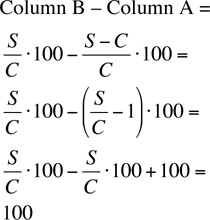
Hence, Column B is 100 units greater than Column A, and the answer is (B).
 Hard
Hard
18. Let c and s be the cost and the selling price, respectively, for the seller on each item.
We are given that the selling price of 15 items equals the cost of 20 items. Hence, we have 15s = 20c, or s = (20/15)c = 4c/3. Now, the profit equals selling price - cost = s - c = 4c/3 - c = c/3. The percentage profit on each item is

The answer is (D).
19. The investors can be categorized into three groups:
(1) Those who have investments in equities only.
(2) Those who have investments in securities only.
(3) Those who have investments in both equities and securities.
Let x, y, and z denote the number of people in the respective categories. Since the total number of investors is 110, we have
|
x + y + z = 110 |
(1) |
Also,
The number of people with investments in equities is x + z and
The number of people with investments in securities is y + z.
Since exactly 25% of the investors in equities have investments in securities, we have the equation
25/100 • (x + z) = z
25/100 • x + 25/100 • z = z
25/100 • x = 75/100 • z
x = 3z (2)
Since exactly 40% of the investors in securities have investments in equities, we have the equation
40/100 • (y + z) = z
2/5 • (y + z) = z
y + z = 5z/2
y = 3z/2 (3)
Substituting equations (2) and (3) into equation (1) yields
3z + 3z/2 + z = 110
11z/2 = 110
z = 110 • 2/11 = 20
Hence, the number of people with investments in equities is x + z = 3z + z = 3 • 20 + 20 = 60 + 20 = 80. The answer is (B).
20. The initial price of the share is $30.
After the $1.2 appreciation on Monday, its price was 30 + 1.2 = $31.2.
After the $3.1 appreciation on Tuesday, its price was 31.2 + 3.1 = $34.3.
After the $4 depreciation on Wednesday, its price was 34.3 - 4 = $30.3.
After the $2 appreciation on Thursday, its price was 30.3 + 2 = $32.3.
After the $0.2 depreciation on Friday, its price was 32.3 - 0.2 = $32.1.
The percentage increase in the price from the initial price is
(32.1 - 30)/30 × 100 =
2.1/30 × 100 =
2.1/3 × 10 =
21/3 = 7
The answer is (D).
21. The square of an integer ends with the digit 1 only if the integer itself either ends with the digit 1 or with the digit 9. For example, 112 = 121 and 192 = 361. Now, there are ten integers ending with 1 from 1 through 100. The numbers are 1,11,21, …,91. Also, there are ten integers ending with 9 from 1 through 100. They are 9,19,29,…, 99. Hence, the total number of integers from 1 through 100 whose squares end with the digit 1 is 20. The number 20 is 20/100 × 100 = 20% of 100. Hence, x = 20.
Similarly, there are twenty integers (1, 11, 21… 191) ending with 1, and twenty integers (9, 19, 29, …, 199) ending with 9. Hence, there are 20 + 20 = 40 integers ending with 1 or 9. Now, 40 is 40/200 × 100 = 20% of the total 200 integers from 1 through 200. So, y also equals 20. Since x = y, the answer is (A).
22. Since the cost of painting increases by a fixed percentage each year and it increased $3,600/$2,000 = 1.8 times in the 9-year period from 1970 to 1979, it must increase by the same number of times in the period 1979 to 1988. Hence, the amount becomes 1.8 × $3,600 = $6480 by 1988. The answer is (E).
23. Let r be the retail price. The list price is the price after a 20% discount on the retail price. Hence, it equals r(1 - 20/100) = r(1 - 0.2) = 0.8r.
The festival discount price is the price after a 30% discount on the list price. Hence, the festival discount price equals (list price)(1 - 30/100) = (0.8r)(1 - 30/100) = (0.8r)(1 - 0.3) = (0.8r)(0.7) = 0.56r.
Hence, the total discount offered is (Original Price - Price after discount/Original Price × 100 = (r -0.56r)/r × 100 = 0.44 × 100 = 44%.
The answer is (C).
24. Since the spinach tins of either brand have the same list price, let each be x dollars. Now, 75% of x is (75/100)x = 3x/4, and 80% of x is (80/100)x = 4x/5. So, spinach tins of brands A and B are sold at 3x/4 and 4x/15, respectively. After festival discounts of 20% and 25% on the respective brand items, the cost of spinach tins drop to  and
and  . Hence, the columns are equal, and the answer is (C).
. Hence, the columns are equal, and the answer is (C).
25. The population of the country grows at a fixed percentage each year. Hence, just as we have a fixed percentage for each year, we will have a different and fixed percentage for each 10-year period (a decade). Let the later rate be R%. Hence, if P is population in 1980, population in 1990 (after a decade) would grow by PR/100 (= Column A). So, population in 1990 would be Original Plus Increase = P + PR/100. Similarly, in the next decade (1990-2000) and at the same rate R% it would increase by (P + PR/100)(R/100) (=Column B). Substituting the results in the columns yields
|
PR/100 |
|
(P + PR/100)(R/100) |
Canceling A/100 from both sides yields
|
P/100 |
|
(P + PR/100) |
Now, Column A = P and Column B = P + PR/100 = Column A + PR/100. Hence, Column B > Column A, and the answer is (B).
26. Let the original cost of Medicine A be a dollars. 5% tax on this equals (5/100)a = a/20. So, the total cost including sales tax is a + a/20 = 21a/20. This equals x dollars (what medicine A cost James). Hence, we have 21a/20 = x. Solving for a yields a = 20x/21. Sales tax on A is  = Column A.
= Column A.
Now, Kate was charged sales tax on Medicine B. The charge was 5% of the cost of the medicine (x). 5% of x is (5/100)x = x/20 = Column B. Since 1/20 > 1/21, x/20 > x/21 and Column B > Column A. The answer is (B).
27. In the first year, fund B was given a growth of 30%. Hence, according to clauses (1) and (2), fund A must have grown by 20% (the other allowed growth percentage clause (1)).
In the second year, according to the clauses (1) and (3), the growth percentages of the two funds will swap between the only allowed values 30% and 20% (clause (1)). Hence, fund A grows by 30% and fund B grows by 20%.
In the third year, according to clauses (1) and (3), the growth percentages will again swap between the only two allowed values 20% and 30% (clause (1)). Hence, fund A grows by 20% and fund B grows by 30%.
Since fund B has a better growth percentage history than fund A in the first three years, the value of fund B will be greater than the value of fund A after three years. Hence, Column B is greater than Column A, and the answer is (B).
28. We do not know whether the $459 price that John paid for the computer was with the discount offer or without the discount offer.
If he did not get the discount offer, the list price of the computer should be $459 and John paid the exact amount for the computer. In this case, Column A (= 459) is less than Column B.
If the price corresponds to the price after the discount offer, then $459 should equal a 10% discount on the list price. Hence, if / represents the list price, then we have $459 = l(1 - 10/100) = l(1 - 1/10) = (9/10)l. Solving the equation for l yields l = (10/9)459 = 510 dollars (a case when discount was offered because the list price is greater than $500). Hence, it is also possible that John got the 10% discount on the computer originally list priced at $510. Here, list price (= Column A) is greater than 500 (= Column B).
Hence, we have a double case, and the answer is (D).
29. Let a dollars be the cost of each egg to Williams. Hence, the net cost of the x eggs is ax dollars.
Now, the selling price of the eggs when selling at 10% profit is a(l + 10/100) = 1 la/10.
The selling price of the eggs when selling at 10% loss is a(l - 10/100) = 9o/10.
We are given that Williams has x eggs and he sold y of them at 10 percent profit (at a selling price of 11a/10) and the rest, x - y, at 10 percent loss (at a selling price of 9a/10). Hence, the net selling price is y(11a/10) + (x - y)(9a/10) = a(0.2y + 0.9x).
Since overall he made a profit, the net selling price must be greater than the net cost. Hence, we have the inequality a(0.2y + 0.9x) > ax.
Canceling a from both sides of the inequality yields 0.2y + 0.9x > x. Subtracting 0.9* from both sides of the inequality yields 0.2y > 0.1x. Multiplying both sides by 10 yields 2y > x. Now, subtracting y from both sides yields y > × - y.
Hence, Column B is greater than Column A. The answer is (B).
30. Since a is 25% greater than c, we have a = (1 + 0.25)c. Substituting this in the given equation ab = cd yields [(1 + 0.25)c]b = cd. Canceling c from both sides yields (1 + 0.25)b = d. This equation indicates that d is 25% greater than b. The answer is (C).
 Very Hard
Very Hard
31. Let p be the income of Mr. Teng in the year 2003.
We are given that his income increased by 20% each year. So, the income in the second year, 2004, must be p(1 + 20/100) = p(1 + 0.2) = 1.2p. The income in the third year, 2005, must be
1.2p(1 + 20/100) =
1.2p(1 + 0.2) =
1.2p(1.2) =
1.44p
Hence, the total income in the three years equals P + 1.2p + 1.44p. Since the total income is 36,400, we have the equation P + 1.2p + 1.44p = 36,400, or 3.64p = 36,400, or P = 36,400/3.64 = 10,000. Hence, the income in the third year equals 1.44p = 1.44 × 10,000 = 14,400. The answer is (E).